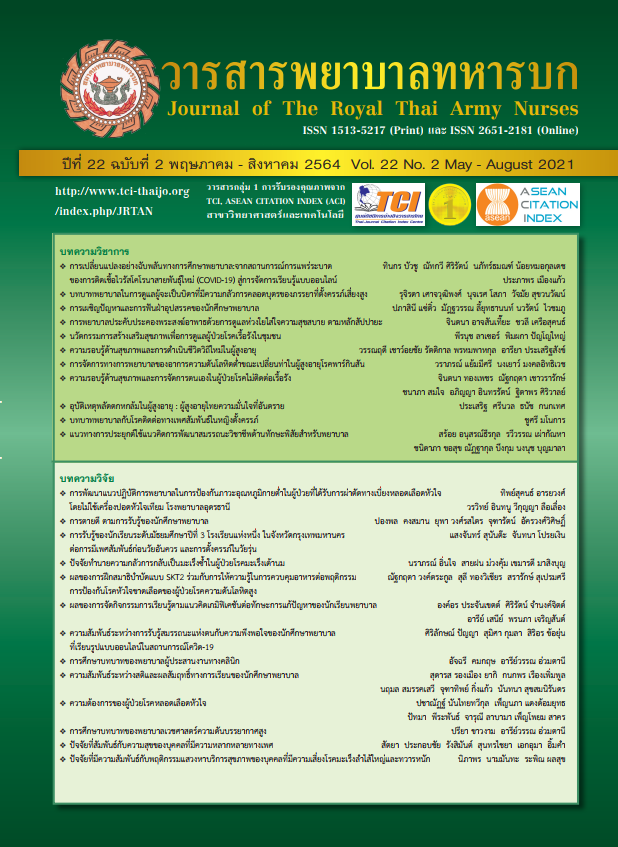Adversity Quotient: Nursing Students
Keywords:
Adversity Quotient, Nursing studentsAbstract
This article aims to present conceptual framework, principles and theories about Adversity Quotient: of nursing students. by presenting the following issues: 1) Concepts and theories of Adversity Quotient, 2) The concept of youth change theory, 3) Contextual concepts of nursing students, and 4) Adversity Quotient of nursing students. It will be based on the CORE conceptual framework to guide students and faculty involved in the application to promote coping and to effectively overcome the obstacles of nursing students.
Downloads
References
Office of the National Economic and Social Development Board The Prime Minister. The 12th National Economic and Social Development Plan, 2017-2019;2017 (In Thai)
Stoltz, Paul G. Adversity Quotient : Turning Obstacles into Opportunities.New York: John Wiley & Sons, 1997
Ruangpermpoon K, Roungmuang S, Ninjan P. Social adaptability characteristics of nursing students. Ramathibodi Nursing Journal 2011; 17(3): 478-492 (in Thai)
Stoltz, Paul G. Adversity Quotient : Turning Obstacles into Opportunities. New York: John Wiley & Sons, 1997
Chailungka S. Emotional Stability and Adversity Quotient among Student at Boromarajonani College of Nursing, Phayao. Nursing Public Health and Education Journal. 2009; 15(2) : 30-39. (in Thai)
Stoltz, Paul G. Adversity Quotient at Work. Newyork: Harper Collins Publishers, 2000
Sindecharuk T, Leangthanarerk P. Adolescent : attitudes and behaviors on the similar and difference of adolescence nowadays: case study student in public and private university. Thammasat University Journal 2014;33 (1): 98-121. (in Thai)
Srisawa K. Stress among Pregnant Adolescents. Journal of The Royal Thai Army Nurses 2016; 17(2):7-11. (in Thai)
Kesa S,Jitpiromsri S. Adolescent and Cultural Violent in Muang District, Satun Province. Parichart Journal, 2015; 28(3): 155-166 (in Thai)
Ruangpermpoon K, Roungmuang S, Ninjan P. Social adaptability characteristics of nursing students.Ramathibodi Nursing Journal. 2011; 17(3): 478-492 (in Thai)
Watson, M.R., Lagow, R.D., Xu, K., Zhang, B., Bonini, N.M. (2008). A drosophila model for amyotrophic lateral sclerosis reveals motor neuron damage by human SOD1. J. Biol. Chem. 283(36): 24972-24981
Luckkana T.Emotional Intelligence and Level of Stress of the First Year Nursing Students at Faculty of Nursing, Chiang Mai Universing. Chiang Mai Universing, 2009. (in Thai)
Pannathad N. A Study of Social Adjustment of Nursing Students at Western University in Buriram province. Western University, 2014 (in Thai)
Chanatda P., Chusri L., Nontirat P. SalfAdjustment Ability of First Year Student in Public University. Journal of KUMTNB, 2011;21(1): 157-166 (in Thai)
Stoltz, Paul G. Adversity Quotient at Work. Newyork: Harper Collins Publishers, 2000
Reanthanapong N et al. The Relationships Between Mental Health And Adjustment Problems Of First Year Nursing Student At Nursing Colleges in The North Under The Jurisdiction of The Nursing College Division, Ministry Of Public Health in Academic Year 1996. The Master of Education Degree in Guidance Phycholy at Naresuan University; 1997 (in Thai)
Downloads
Published
How to Cite
Issue
Section
License
บทความหรือข้อคิดเห็นใดใดที่ปรากฏในวารสารพยาบาลทหารบกเป็นวรรณกรรมของผู้เขียน ซึ่งบรรณาธิการหรือสมาคมพยาบาลทหารบก ไม่จำเป็นต้องเห็นด้วย
บทความที่ได้รับการตีพิมพ์เป็นลิขสิทธิ์ของวารสารพยาบาลทหารบก
The ideas and opinions expressed in the Journal of The Royal Thai Army Nurses are those of the authors and not necessarily those
of the editor or Royal Thai Army Nurses Association.






